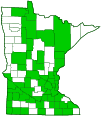Oat Crown Rust
(Puccinia coronata f. sp. avenae)
Glossary
Awn
A stiff, bristle-like appendage at the tip of the glume, lemma, or palea of grass florets.
Culm
The hollow or pithy stem of a grass, sedge, or rush.
Peduncle
In angiosperms, the stalk of a single flower or a flower cluster; in club mosses, the stalk of a strobilus or a group of strobili.
Sheath
The lower part of the leaf that surrounds the stem.

| Slideshows | ||
| Rez korunkatá - Puccinia coronata Jiří Laštůvka - Kudláček |
||
About
Published on Jul 17, 2012 No description available. |
||

| Visitor Videos | |||
Share your video of this fungus. |
|||
This button not working for you? |
|||
| Other Videos | |||
| Oat leaf infected by Puccinia coronata CUPlantPathPhotoLab |
|||
About
Published on Aug 17, 2012 We're looking at the surface of an oat leaf. The orange spots are developing masses of spores of the fungus Puccinia coronata, which causes oat crown rust. These rust-colored spores (urediniospores) become wind-borne and can cause new infections on oat leaves, and also a wide range of other grasses including barley. Not shown: the secret life of P. coronata on its alternate host, common buckthorn. The video was taken over 5 days and 18 hours in our lab. This rust can make a bazillion microscopic spores in that time. |
|||

| Visitor Sightings | ||||
Report a sighting of this fungus. |
||||
|
This button not working for you? Simply email us at info@MinnesotaSeasons.com. Be sure to include a location. |
||||
| MinnesotaSeasons.com Sightings | ||||

Last Updated:




